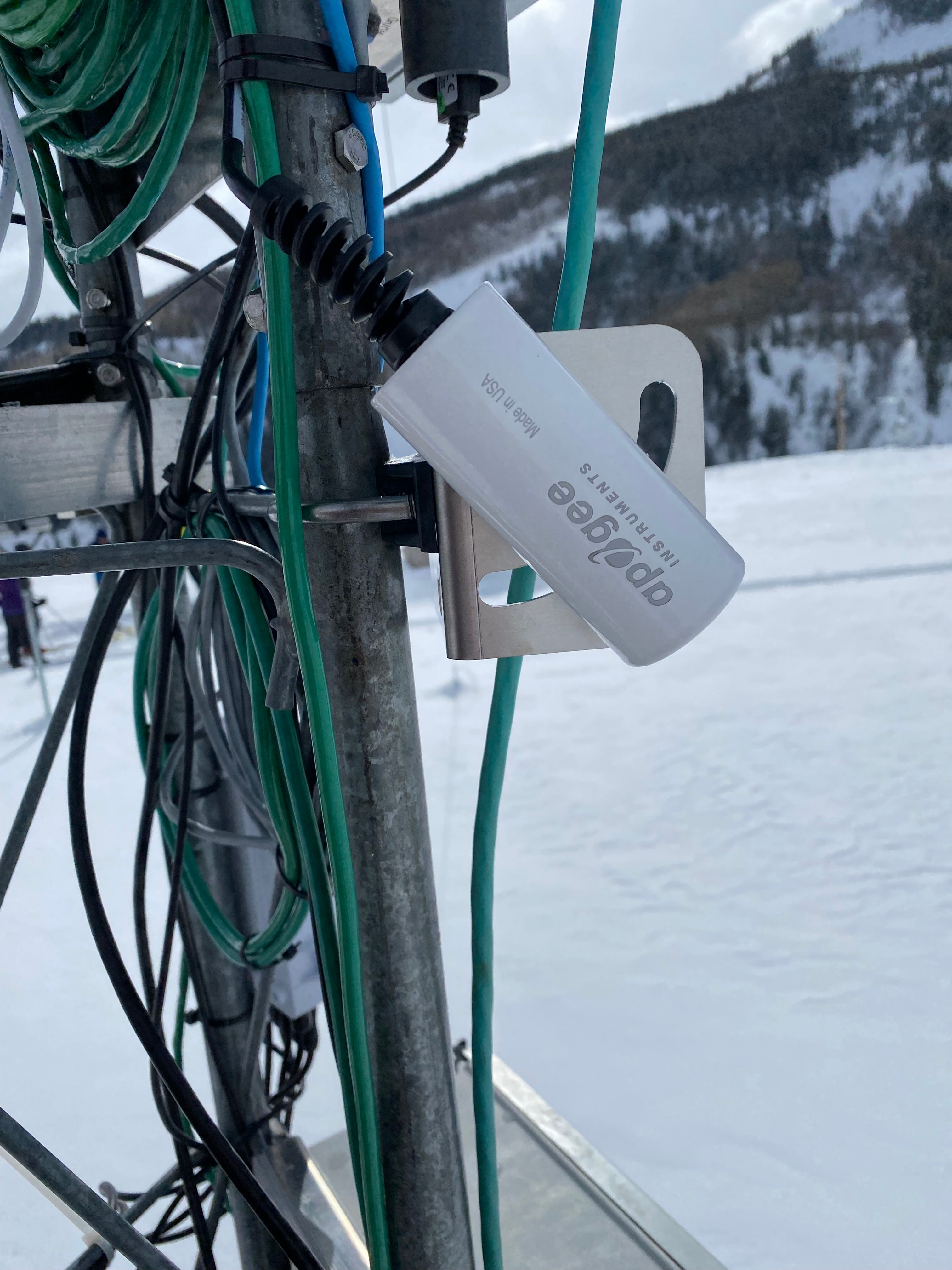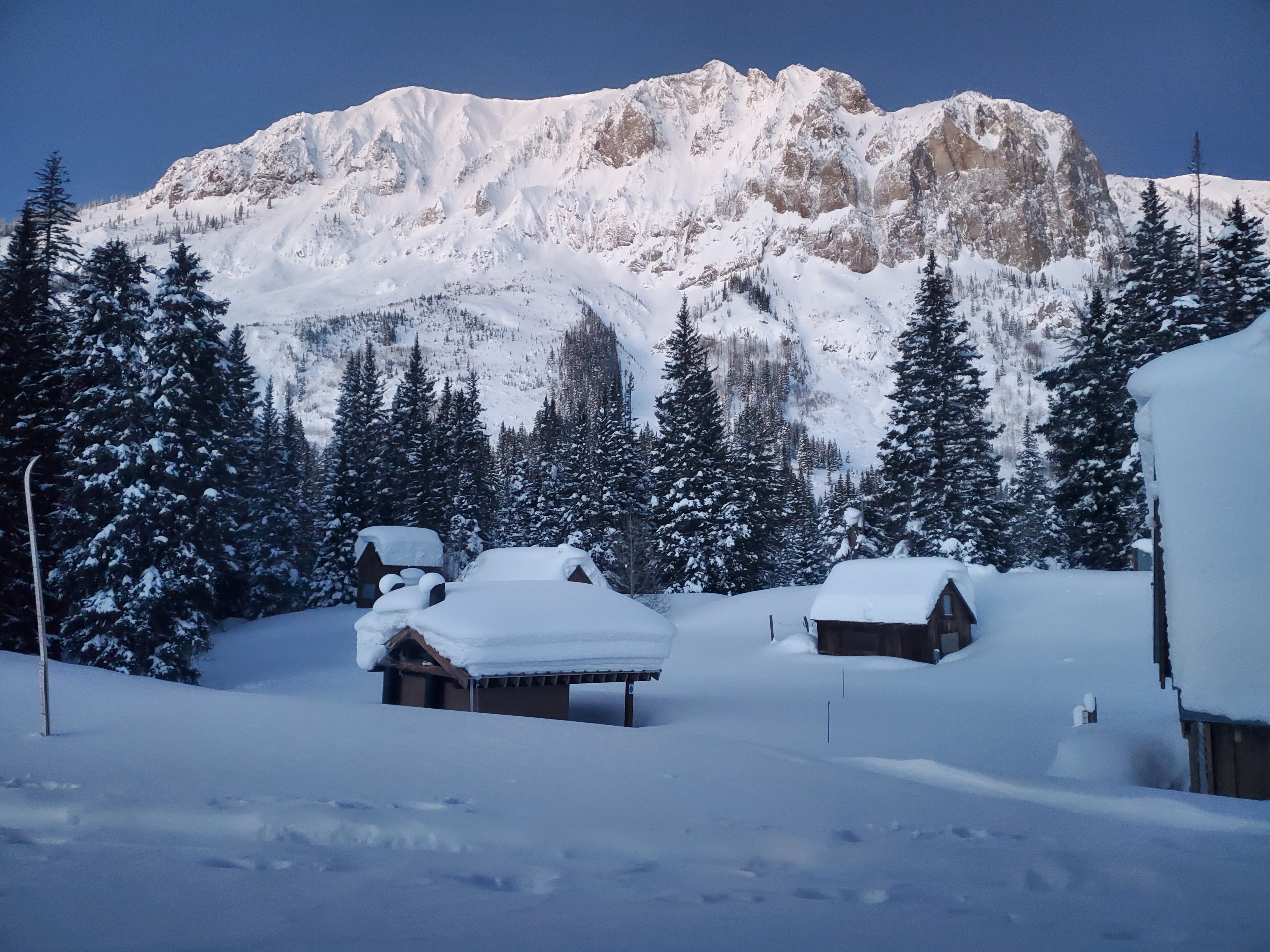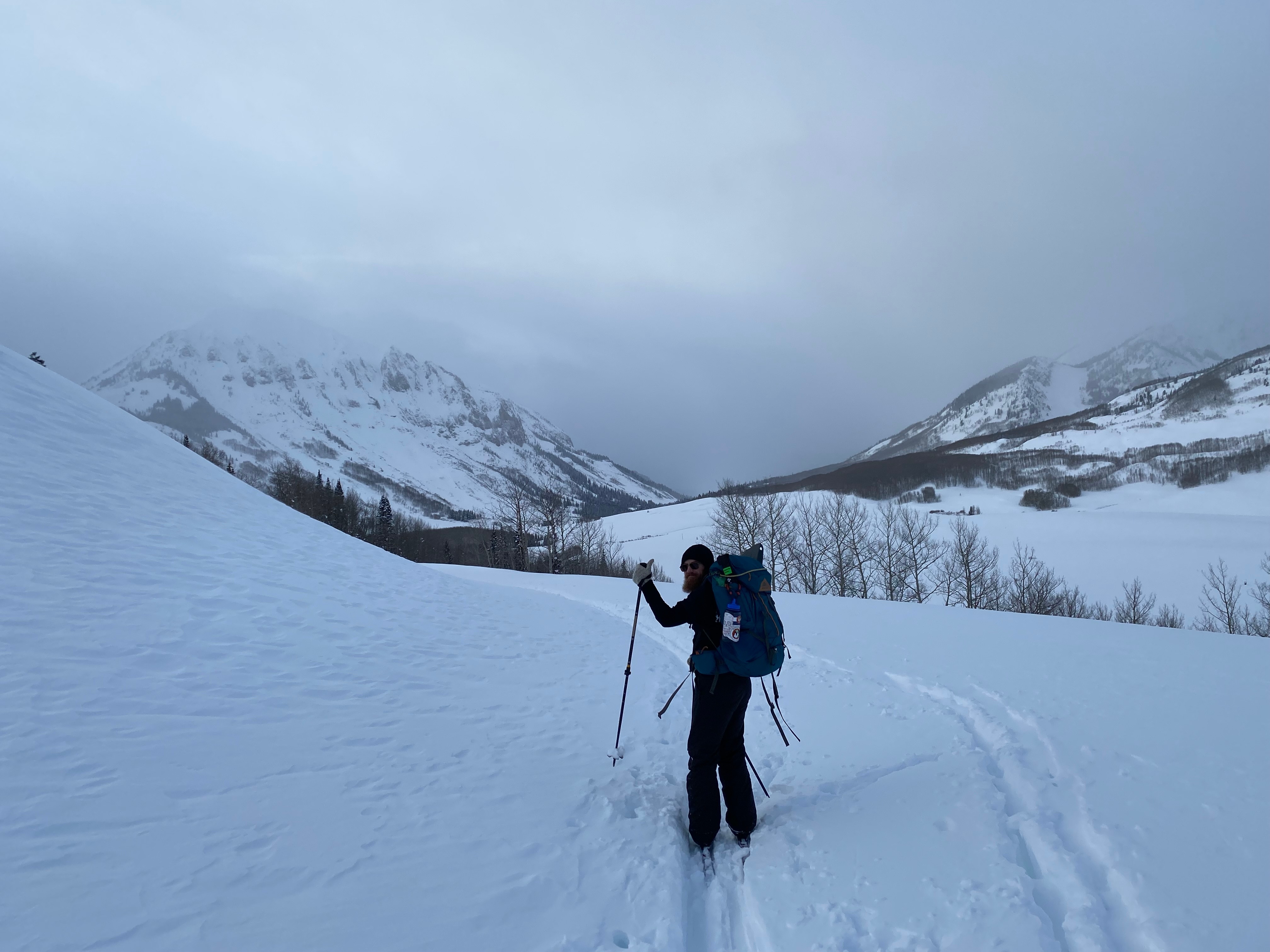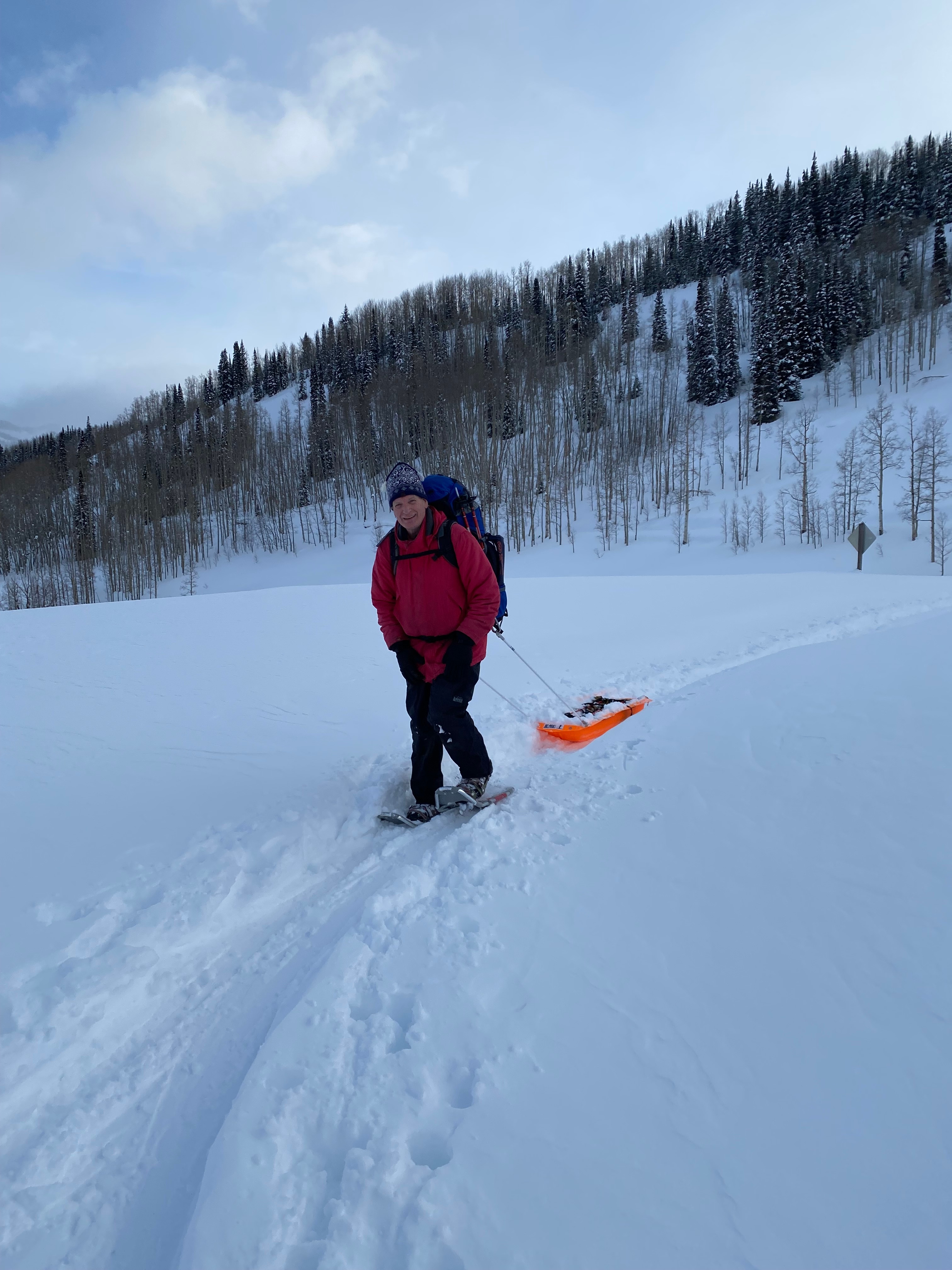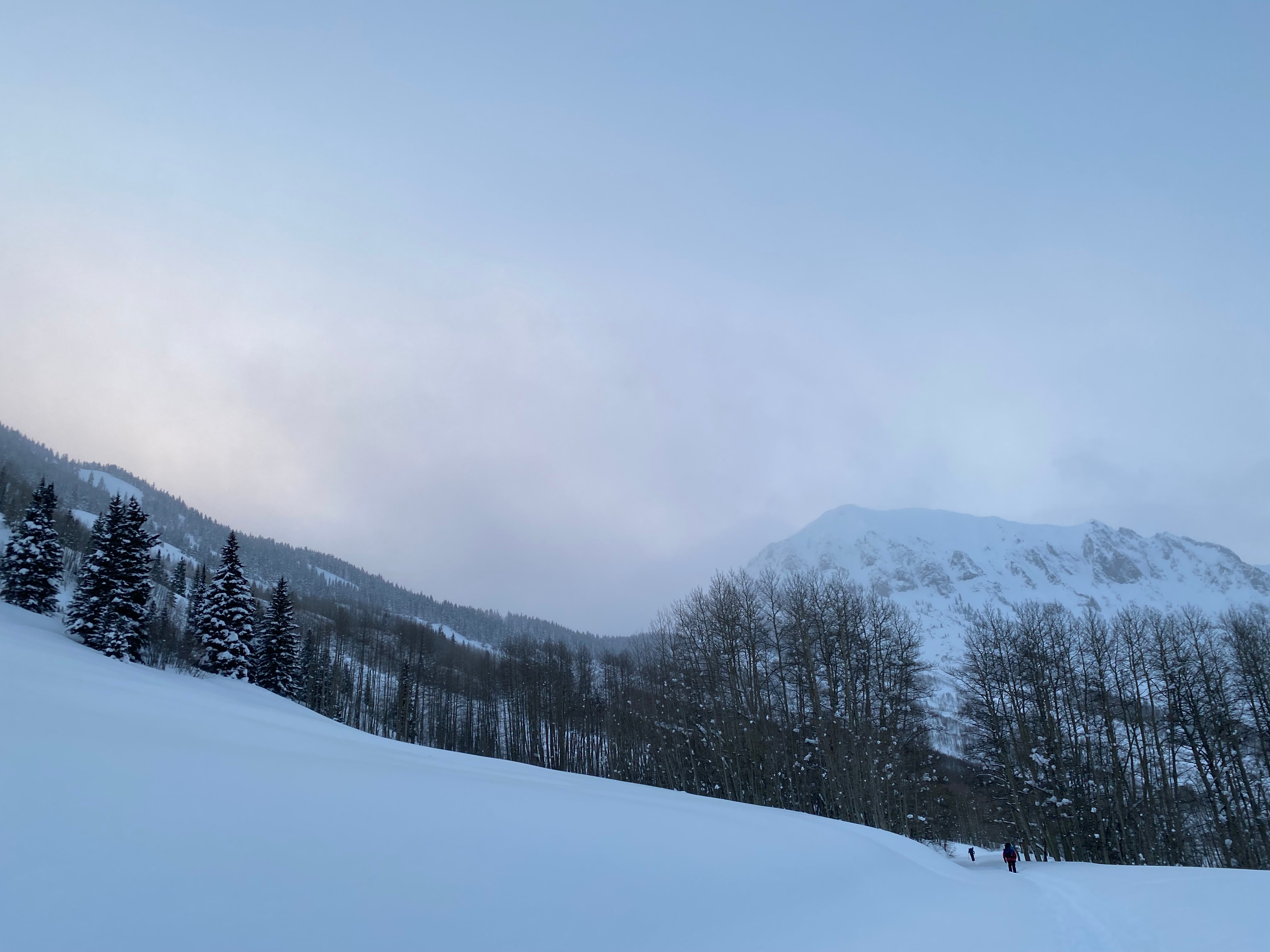Antonio and I visited the site today to check out the GPS nsat on the ue tower. We ended up replacing the GPS antenna at 12:45 because the number of connected satellites was hovering around 3. So far the replacement has improved the connectivity, and the number hovers above 6 satellites. We will continue to monitor the changes throughout the evening.
Will and Steve skied out today. Will and Antonio skied back in. All made the transit safely.
Jessica, Danny, Eli, and Ethan went to the site and dug a snow pit. Ethan opened the box and looked at the GPS on the ue tower. He pushed the cables a bit so that the antenna was no longer crowded. It now appears to be working.
Danny and Eli set up the thermal IR sheet, and we saw some cool turbulence. It was windy (5 m/s) and very cold (-8 C) – weather to make your fingers feel numb. (Much nicer to be in the snow pit than up above.)
As of about 4pm yesterday, the number of satellites from the ue GPS is low, and we're even getting missing data from it. My guess is that something got bumped when Ethan retrieved his lidar SD memory cards. We won't deal with this tomorrow, so it will need to be looked at Wed.
Partly sunny, calm winds, top snow layer a bit softer again
Still Will and Steve and the PI team
A quick trip by Will and Steve to the site, mostly to debug the uw Apogee which had Vpile readings that were too large in magnitude. Reseating cables didn't change. Swapping the popsicle stick with a spare did help (about 10:30). Now the readings look good.
We also thought to measure the displacement between the sonic and quad-disk ports, but they are too high to measure directly. I just shot photos (soon to be attached) so that we can evaluate the distance photogrammetrically. In the process, noticed that 10m.c had blown close to the sonic, so Will climbed to shift it back. (On the tower from about 11:00 to 11:15.) I have before and after photos.
Returned in time to miss only the first few minutes of Ethan's talk to the SAIL/SPLASH team.
This is my last scheduled site visit. I'm leaving tomorrow, to be replaced by Antonio.
Jessica asked for the Apogees to be sampled faster, since these sensors should have a short time constant. I've just entered a "RAT 1" command to all 4. Hopefully, the PIC will be okay at this rate.
Also, I just found that we should have been using the "CRBasic" coefficients in my dat.Tsfc.Ap code, which are higher than the "Edlog" coefficients by a factor of 100,000. dat.Tsfc.Ap has now been updated. Unfortunately, the new code shows that Vpile.uw is now off. We'll check for a (again) cabling issue tomorrow and/or swap out the mote if we have a spare.
Today I joined Jessica, Danny, Eli, and Emilio at the field site where they dug up a pit and looked at the density of the snow at each 10 cm layer. The snow pack was at 122 cm today. Danny also installed 3 pressure sensors into the snow surface (1.1m at 10cm below snow surface (bss), 0.9m at 5cm bss, and 0.8m at 3cm bss) and left the 1.1m open but not in the snow surface. Ethan and Julie headed out to the site later in the day to pull more data from the lidar sd cards.
Overall, it was a warm and awesome day. Danny, Emilio, and Eli took me skiing in the afternoon for my first taste of powder! The SOS team is making a family dinner again, this time Cincinnati chili (:
Tomorrow we will measure the pressure port separation, look at the uw apogee cable, and try to check out the green comet C/2022 E3 (ZTF).
Cooler, a bit of wind (and thus blowing snow).
Everyone visited the site during the middle of the day. The tasks I know of:
- The PIs dug a snow pit, and explained it to us
- Danny connected a pressure inlet in the snow to P.0.8m
- Ethan downloaded 3 of his lidar SD cards
- Will climbed "d" again:
- replaced the lidar pointing at ue (I think Ethan called this #5)
- Will also managed to get the 4th bolt secured to Rsw.in's CVF4, cleaning up the small mess I made yesterday
- pointed the Apogee down a bit more (from about 45 degrees to 35 degrees)
- We also raised the barrel so its top is about 1' above the snow, rather than 1' below (for the moment!). People will have to watch it as the snowpack deteriorates as the barrel will eventually fall off of its (now) snow platform
I also appreciate that the PI's (actually Danny) established a different 2-track to the site, so I now have my own snowshoe track.
Overcast, making it feel colder, but making the snow cruchier (and thus a bit easier to walk)
Tony left today – Home duties called (or was it cried)? We chose not to accompany him, since avalanche conditions are only Moderate. We did arrange walkie-talkie check-ins every 15-30 minutes, and Will and I went to Kettle Ponds at the same time, so we had a good connection. By the time he got to the trailhead (about 1:40 total trip), we were at Kettle Ponds and were able to communicate with our phones. Thanks for your help and great attitude, Tony!
At the site, we did our remaing tasks:
Arrived at site at 0938
Read pillow serial numbers:
Pillow SN 1 22001 2 22003 3 (the one we opened) 22004 4 can't read due to the way it is mounted - secured the Tsnow mote box
- replaced the cap on the DSM port for the EC100 at 1m.c, that we had disconnected yesterday.
- most of the time was working on Rsw.in.9m.d. Indeed, its fan wasn't running (the other 3 were working). Ultimately, I think the problem is a loose connection in the Lemo(?) connector at the end of the K&Z yellow cable. This connector has a hex nut and also a knurled "nut" for tightening. On this one cable, the hex nut was loose and it was very hard to turn the knurled nut without further loosening the hex. In the end, I swapped this cable with the ventillator for Rsw.out.9m.d, but miraculously, it stayed connected and was working when I left.
- It was hard, doing all this since the Rsw radiometers are at the far end of the boom, requiring a long reach. The only way I could manage was to remove the entire Rsw.in radiometer and ventillator plate. We had brought an extra, so I went ahead and swapped it in even though I was able to get the old ventillator fan running connected to a different yellow cable. I could only get 3 of the 4 bolts holding the ventillator to its standoffs. I left the 4th loose inside the housing. We just need to loosen the bottom of the standoff, but I didn't have a wrench. Maybe later this visit. All this took almost 2 hours, with me taking several breaks just to stretch and put my gloves back on. Poor Will had to stand on his skis below me the entire time. Sorry, Will!
- At 1208, I cleaned all radiometers and came down.
- Had lunch, left site about 1310.
Jessica, Ethan, and team arrived at (their) cabin about the same time that we got back to ours.
Finally got a chance to test both the TRH.12m that Chris and Antonio brought down during the December visit and the TRH.6m that we just retrieved today.
TRH.12m works fine, with the fan responding appropriately to changes in the fan duty cycle. However, the RPM reading is flakey – reads mostly -99 with TRH057 and erratic values with TRH117. We've labeled the housing "bad rpm".
TRH.6m also works fine in the cabin. The fan RPM reports in the 5400 range for both TRH057 and TRH117. We suspect that this fan just doesn't like the cold. We'll label it as such.
Thus, we think that both TRH probes are fine.
Done with this task.
Other information (mostly for me):
- we tested with the DSM labeled "spare 1", that comes up with wifi ID "s1". With Gary's help we found that it's IP address is 192.168.1.221.
- In the end, I used minicom dsm1, that was defined. I also don't know if it was needed, but I also used dsm_port_config to set dsm1 to RS232.
NOTES:
At 12:05 Steve cleaned the NR01
At 12:15 Steve flipped the wetness sensor
The 6m TRH was replaced around this time as well.
We retrieved the sled this morning. It appeared undisturbed. It now lives in the Salamander room. I found pulling the sled with Xskis pretty smooth. Trouble is, if the trail is narrow the sled fills up with snow as you go. The snow hardens and increases the load weight. We could use a cover. If you chose to use the sled, I suggest bringing extra rope for a two person pull for heavy loads or uphill sections.
Our transit to the site was steady. Steve broke trail on the existing ski track with snow shoes and Will and I followed in skis. I found xskis work pretty great until you need to go uphill in deep snow. Overall very manageable and recommended. If you come out and want to visit the site follow the orange flags.
The onsite barrel is completely full. Completely. No more stuff please.
Gothic road was groomed today. We should consider communicating with winter residents for Gothic road status. As of late they have been grooming on Thursdays.
The cb dsm now has a script installed which monitors the snow pillow data. If any pillow does not report Load data for 20 minutes, the script cycles the BANK1 power relay. There is a built-in recovery time of 1 hour, so if a sensor is broken for some other reason, the power will never cycle more often than once an hour. The crontab entry which cycled power once each day has been commented out.
The script is running as a systemd user unit. Use this command to see the status:
daq@cb:~ $ systemctl --user status snow_pillows_monitor.service
● snow_pillows_monitor.service - Monitor snow pillows at SOS and cycle power when a pillow not reporting.
Loaded: loaded (/home/daq/isfs/projects/SOS/ISFS/scripts/./snow_pillows_monitor.service; enabled; vendor preset: enabled)
Active: active (running) since Thu 2023-01-19 21:19:34 UTC; 2h 35min ago
Main PID: 5611 (python3)
CGroup: /user.slice/user-1001.slice/user@1001.service/snow_pillows_monitor.service
├─5611 python3 /home/daq/isfs/projects/SOS/ISFS/scripts/snow_pillows_monitor.py --log info
└─5626 data_stats -p -a -i 40,1052 -i 40,1054 -i 40,1056 -i 40,1058 -P 60 -n 0 --json /tmp/data_stats.abemv6jg/data_stats.json
Jan 19 23:20:37 cb bash[5611]: INFO:__main__:updated stream SOS.40.1056: {"Load.1.p3":[48.462],"Load.2.p3":[53.189],"Load.3.p3":[50.822],"Load.4.p3":[46.256],"streamid":"SOS.40.1056","time":["2023-01-19T23:
Jan 19 23:21:37 cb bash[5611]: INFO:__main__:updated stream SOS.40.1058: {"Load.1.p4":[52.252],"Load.2.p4":[47.441],"Load.3.p4":[52.397],"Load.4.p4":[51.611],"streamid":"SOS.40.1058","time":["2023-01-19T23:
Use this command to watch the log output:
daq@cb:~ $ journalctl --user -f --unit snow_pillows_monitor
The details will be in this Jira issue:
https://jira.ucar.edu/browse/ISFS-576
Yesterday, Tony, Will, and I drove from Boulder and traveled into the site. Due to snow across Colorado, we were rather late getting to the trailhead – we had to clean off snow from the NCAR pickup before leaving, and Monarch Pass in particular was quite slow, with almost no visibility at times. We also took a few minutes to check in at the RMBL office in Crested Butte. With another half hour to unload and repark the cars (Tony drove seperately), we started out about 3:30pm.
We took our time, Tony was on regular cross-country skis, Will on backcountry skis with skins, and I used snowshoes. We also had the sled, which started out lightly loaded. We had a few gear issues, the buckle for my backpack chest strap broke and Will's bindings sometimes didn't want to snap in, and Nalgene water bottle lids froze. Unlike last year, the trail only had the ski 2-track from Danny and Eli's resupply trip into town the day before. (All the recreational users seemed to be going up Snodgrass.) The snowpack was pretty loose, with a bit of a crust. Thus, my snowshoes were too wide for the track and I was always breaking trail on the side and sliding off the "hump" of packed snow in the middle of the trail. For the first half of the trip, I had the sled, since I thought it would be easier to manage with the snowshoes, which generally was true. Oh, and each of us had farily heavily loaded packs. I, at least, started getting really tired with this, Tony did well on his skis, and Will was in the middle.
Full dark found us still about a mile out. Will had brought 2 headlamps, but neither Tony or I had them (I always assumed that we'd only be out in daylight). The batteries in one of the headlamps eventually died, so we were navigating by Will's headlamp and starlight. Not <too> bad, since we had a clear track. However, at one point there was a fork, where we took the newer track. This ended up being a mistake, so we had to backtrack, involving turning around with skis and sled in the soft snow, which ultimately delayed us about 20 minutes. I was so tired by then that we tried dumping my pack in the sled which Tony pulled except for times going uphill when his skis couldn't grab enough. Just beyond the bridge near Gothic, we were exhausted enough that we abandoned the sled and pack, finally getting to Maroon cabin about 8:20. Tony still had a bit of energy and graciously dumped his pack and went back for mine. FInally everyone was back in the cabin by about 8:45. We left the sled by the trail and will pick it up this morning.
We worked together to balance the load, had good communication, and took the time we needed, knowing that we had a warm cabin waiting for us. Once there, Danny and Eli were great hosts.
We did have a wonderful view of the stars/Milky Way, and even saw the ISS (not Bill's facility!) pass overhead.
After a break, Eli and I went up to the RMBL lab to recover wstar and two food bags. With some help from Will, I installed the R-eol packages. I also copied the netcdf files to date from our FTP site to wstar. I couldn't get Firefox to access these files and didn't know how to scp them through gate, so I just installed ftp onto wstar, which worked fine. (Sorry, security folks.)
Danny and Eli moved the sonics from 1 m to 2 m, yesterday at the following times, mountain time:
The times listed below indicate the times that they were at the base of the towers, moving the arms and digging out the sensors (tower UW required some real digging, tower D just a tiny bit).
- Time modifying towerrs:
- UE: 10:48 - 11:02am
- UW: 11:07 - 11:39am
- D: 11:40 - 11:47am
They checked afterwards, and the moved sonics were recording yesterday afternoon.
However, the data seems to have stopped reporting at about 6 pm last night. Thanks.
The images from the camera on tower d are now being downloaded every hour, and one image for each hour can be browsed through the ISFS QC tables and plots page.
The most recently downloaded image is available at this link: https://archive.eol.ucar.edu/docs/isf/projects/SOS/isfs/qcdata/images/latest.jpg.
The latest image has also been embedded in the wiki front page, with a link to the latest day's images.
If anyone notices a problem or has a question, feel free to comment on this blog post.
Now restarted. Sigh.







